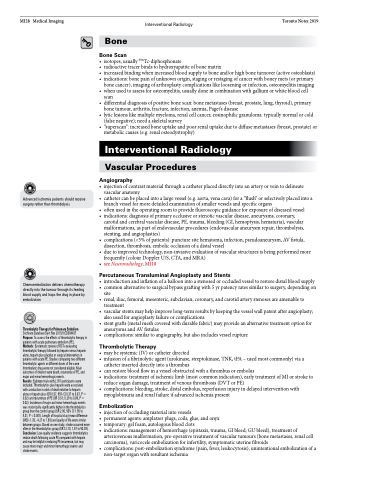Page 696 - TNFlipTest
P. 696
MI28 Medical Imaging
Interventional Radiology Toronto Notes 2019
Advanced ischemia patients should receive surgery rather than thrombolysis
Chemoembolization delivers chemotherapy directly into the tumour through its feeding blood supply and traps the drug in place by embolization
Thrombolytic Therapy for Pulmonary Embolism
Cochrane Database Syst Rev 2015;9:CD004437
Purpose: To assess the effects of thrombolytic therapy in patients with acute pulmonary embolism (PE).
Methods: Systematic review of RCTs evaluating thrombolytic therapy followed by heparin versus heparin alone, heparin plus placebo or surgical intervention in patients with acute PE. Studies comparing two different thrombolytic agents or different doses of the same thrombolytic drug were not considered eligible. Main outcomes of interest were death, recurrence of PE, and major and minor hemorrhagic events.
Results: Eighteen trials with2,197 participants were included. Thrombolytics plus heparin were associated
with a reduction in odds of death relative to heparin
alone or heparin plus (OR 0.57, 95% CI 0.37 to 0.87, P = 0.02) and recurrence of PE (OR 0.51; 0.29 to 0.89, P = 0.02). Incidence of major and minor hemorrhagic events was statistically significantly higher in the thrombolytics group than the control group (OR 2.90, 95% CI 1.95 to 4.31, P <0.001). Length of hospital stay (mean difference (MD) -1.35, -4.27 to 1.58) and quality of life were similar between groups. Based on one study, stroke occurred more often in the thrombolytics group (OR 12.10, 1.57 to 93.39). Conclusion: Low-quality evidence suggests thrombolytics reduce death following acute PE compared with heparin and may be helpful in reducing PE recurrence, but may cause more major and minor hemorrhagic events and stroke events.
Bone
Bone Scan
• isotopes,usually99mTc-diphosphonate
• radioactivetracerbindstohydroxyapatiteofbonematrix
• increasedbindingwhenincreasedbloodsupplytoboneand/orhighboneturnover(activeosteoblasts) • indications:bonepainofunknownorigin,stagingorrestagingofcancerwithboneymets(orprimary
bone cancer), imaging of arthroplasty complications like loosening or infection, osteomyelitis imaging • whenusedtoassessforosteomyelitis,usuallydoneincombinationwithgalliumorwhitebloodcell
scan
• differentialdiagnosisofpositivebonescan:bonemetastases(breast,prostate,lung,thyroid),primary
bone tumour, arthritis, fracture, infection, anemia, Paget’s disease
• lyticlesionslikemultiplemyeloma,renalcellcancer,eosinophilicgranuloma:typicallynormalorcold
(false negative); need a skeletal survey
• “superscan”:increasedboneuptakeandpoorrenaluptakeduetodiffusemetastases(breast,prostate)or
metabolic causes (e.g. renal osteodystrophy)
Interventional Radiology
Vascular Procedures
Angiography
• injectionofcontrastmaterialthroughacatheterplaceddirectlyintoanarteryorveintodelineate vascular anatomy
• catheter can be placed into a large vessel (e.g. aorta, vena cava) for a “flush” or selectively placed into a branch vessel for more detailed examination of smaller vessels and specific organs
• oftenusedintheoperatingroomtoprovidefluoroscopicguidanceforexposureofdiseasedvessel • indications:diagnosisofprimaryocclusiveorstenoticvasculardisease,aneurysms,coronary,
carotid and cerebral vascular disease, PE, trauma, bleeding (GI, hemoptysis, hematuria), vascular malformations, as part of endovascular procedures (endovascular aneurysm repair, thrombolysis, stenting, and angioplasties)
• complications(<5%ofpatients):puncturesitehematoma,infection,pseudoaneurysm,AVfistula, dissection, thrombosis, embolic occlusion of a distal vessel
• duetoimprovedtechnology,non-invasiveevaluationofvascularstructuresisbeingperformedmore frequently (colour Doppler U/S, CTA, and MRA)
• seeNeuroradiology,MI18
Percutaneous Transluminal Angioplasty and Stents
• introductionandinflationofaballoonintoastenosedoroccludedvesseltorestoredistalbloodsupply • commonalternativetosurgicalbypassgraftingwith5yrpatencyratessimilartosurgery,dependingon
site
• renal, iliac, femoral, mesenteric, subclavian, coronary, and carotid artery stenoses are amenable to
treatment
• vascularstentsmayhelpimprovelong-termresultsbykeepingthevesselwallpatentafterangioplasty;
also used for angioplasty failure or complications
• stentgrafts(metalmeshcoveredwithdurablefabric)mayprovideanalternativetreatmentoptionfor
aneurysms and AV fistulas
• complications:similartoangiography,butalsoincludesvesselrupture
Thrombolytic Therapy
• maybesystemic(IV)orcatheterdirected
• infusion of a fibrinolytic agent (urokinase, streptokinase, TNK, tPA – used most commonly) via a
catheter inserted directly into a thrombus
• canrestorebloodflowinavesselobstructedwithathrombusorembolus
• indications: treatment of ischemic limb (most common indication), early treatment of MI or stroke to
reduce organ damage, treatment of venous thrombosis (DVT or PE)
• complications: bleeding, stroke, distal embolus, reperfusion injury in delayed intervention with
myoglobinuria and renal failure if advanced ischemia present
Embolization
• injectionofoccludingmaterialintovessels
• permanentagents:amplatzerplugs,coils,glue,andonyx
• temporary: gel foam, autologous blood clots
• indications:managementofhemorrhage(epistaxis,trauma,GIbleed,GUbleed),treatmentof
arteriovenous malformation, pre-operative treatment of vascular tumours (bone metastases, renal cell
carcinoma), varicocele embolization for infertility, symptomatic uterine fibroids
• complications:post-embolizationsyndrome(pain,fever,leukocytosis),unintentionalembolizationofa
non-target organ with resultant ischemia


